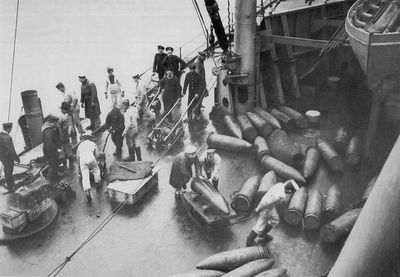H.M.S. Lion (1910)
| H.M.S. Lion (1910) | |
|---|---|
| Pendant Number: | 22 (1914) 79 (Jan 1918) 67 (Apr 1918)[1] |
| Builder: | Devonport Royal Dockyard[2] |
| Ordered: | 1909 Programme[3] |
| Laid down: | 29 Nov, 1909[4] |
| Launched: | 6 Aug, 1910[5] |
| Commissioned: | May, 1912[6] |
| Sold: | 31 Jan, 1924[7] |
| Fate: | Scrapped |
Contents
Construction
Armament
Lion was equipped with the Vickers-designed[8] 13.5-inch gun and mounting. Her mountings were constructed by Armstrongs and fired the lighter 1,250lb projectile, and were designated Mk II. The gun firing circuits were powered by on-mounting dynamos driven by water-turbine Pelton wheels fed by the hydraulic main.[9]
Secondary Battery
Lion differed from Princess Royal (and probably Queen Mary) in using a P IV* mounting as in the Colossus class for her sixteen 4-in guns.
Reconstruction
Lion was taken in hand by Devonport Dockyard on 12 February, 1912. At that time her acceptance trial was projected to take place on 11 March.[10] She commissioned at Devonport on 4 June as Flagship of Rear-Admiral Lewis Bayly.[11]
Career
Late war Gunnery Officer William Bayard Hynes
Jutland
The officer in charge of the T/S at Jutland was Sub-Lieutenant R.P. Selby.
According to the notes of Lieutenant-Commander Gerald Fortescue Longhurst, Lion's "A", "B", and "X" turrets expended 314 rounds of 13.5-inch A.P.C. Lyddite shell. "A" turret expended 95, "B" 107, "X" 112, and "Q" turret 12 before loss. At 20:38 "A" turret had 56 rounds per gun remaining, "B" 50, and "X" 50.[12]
Alterations
In 1913, Lion was slated as part of the seventeen ship order to receive a director. It was fitted sometime after the war started but prior to May, 1915.[13]
In May, 1917, in recognition of shortcomings in the use of directing guns, it was ordered that Lion and Princess Royal should be fitted with a second tripod-type director aft, as described on the class page. Lion received her second director during a refit in September, 1918.[14]
Fate
Captains
Dates of appointment are provided when known.
- Captain Crawford Maclachlan, 19 September, 1911.[15]
- Captain Arthur A. M. Duff, November, 1911.[16]
- Captain A. Ernle M. Chatfield, 1 March, 1913.[17]
- Captain Roger R. C. Backhouse, 30 November, 1916.[18]
- Captain Hugh F. P. Sinclair, 22 May, 1918.[19]
- Captain Arthur J. Davies, May, 1918.[20]
- Captain Wilfred Tompkinson, 17 March, 1919.[21]
See Also
- Wikipedia
- 3D Model of Queen Mary available for licensing, adaptable to Lion
Footnotes
- ↑ Dittmar; Colledge. British Warships 1914–1919. p. 35.
- ↑ Dittmar; Colledge. British Warships 1914–1919. p. 35.
- ↑ Conway's All the World's Fighting Ships 1906–1921. pp. 28-9.
- ↑ Conway's All the World's Fighting Ships 1906–1921. p. 29.
- ↑ Dittmar; Colledge. British Warships 1914–1919. p. 35.
- ↑ Conway's All the World's Fighting Ships 1906–1921. p. 29.
- ↑ Dittmar; Colledge. British Warships 1914–1919. p. 35.
- ↑ Roberts. Battlecruisers. p. 87.
- ↑ Roberts. Battlecruisers. p. 88.
- ↑ "The Battle Cruiser Lion" (News). The Times. Tuesday, 13 February, 1912. Issue 39820, col B, p. 8.
- ↑ Roberts. Battlecruisers. p. 123.
- ↑ British Library. Jellicoe Papers. Add. MSS. 49029. f. 107.
- ↑ The Technical History and Index: Fire Control in HM Ships, pp. 9-10.
- ↑ The Technical History and Index: Fire Control in HM Ships, pp. 18-9.
- ↑ "Naval Appointments" (Official Appointments and Notices). The Times. Monday, 11 September, 1911. Issue 39687, col G, p. 11.
- ↑ Roberts. Battlecruisers. p. 123.
- ↑ "Naval and Military Intelligence" (Official Appointments and Notices). The Times. Friday, 7 February, 1913. Issue 40129, col C, p. 11.
- ↑ The Navy List (November, 1917). p. 395d.
- ↑ Sinclair Service Record. The National Archives. ADM 196/43. f. 368.
- ↑ The Navy List (December, 1918). p. 832.
- ↑ The Monthly Navy List (August, 1919). p. 832.
Bibliography
- Dittmar, F.J.; Colledge, J.J. (1972). British Warships 1914–1919. London: Ian Allan.
- Admiralty, Technical History Section (1919). The Technical History and Index: Fire Control in H.M. Ships. Vol. 3, Part 23. C.B. 1515 (23) now O.U. 6171/14. At The National Archives. ADM 275/19.
- Template:BrooksDreadnoughtGunnery
- Admiralty, Gunnery Branch (1917). The Director Firing Handbook. O.U. 6125 (late C.B. 1259). Copy No. 322 at The National Archives. ADM 186/227.
- Admiralty, Gunnery Branch (1918). Handbook of Captain F. C. Dreyer's Fire Control Tables, 1918. C.B. 1456. Copy No. 10 at Admiralty Library, Portsmouth, United Kingdom.
- Sumida, Jon Tetsuro (1989). In Defence of Naval Supremacy: Finance, Technology and British Naval Policy, 1889-1914. Winchester, Mass.: Unwin Hyman, Inc.. ISBN 0044451040. (on Amazon.com and Amazon.co.uk).
| Lion Class Battlecruiser | |||||||||||||||||||||||||||||||||||||||||||||||||||||||||||||||||||||||||||||||||||||||||||||||||||||||||||||||||||||||
| Lion | Princess Royal | Queen Mary | |||||||||||||||||||||||||||||||||||||||||||||||||||||||||||||||||||||||||||||||||||||||||||||||||||||||||||||||||||||
| <– | Indefatigable Class | Major Cruisers (UK) | H.M.S. Tiger | –> | |||||||||||||||||||||||||||||||||||||||||||||||||||||||||||||||||||||||||||||||||||||||||||||||||||||||||||||||||||
